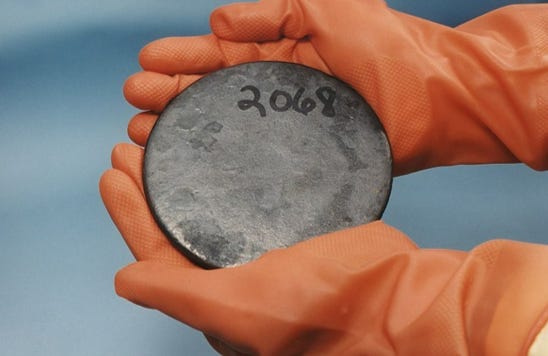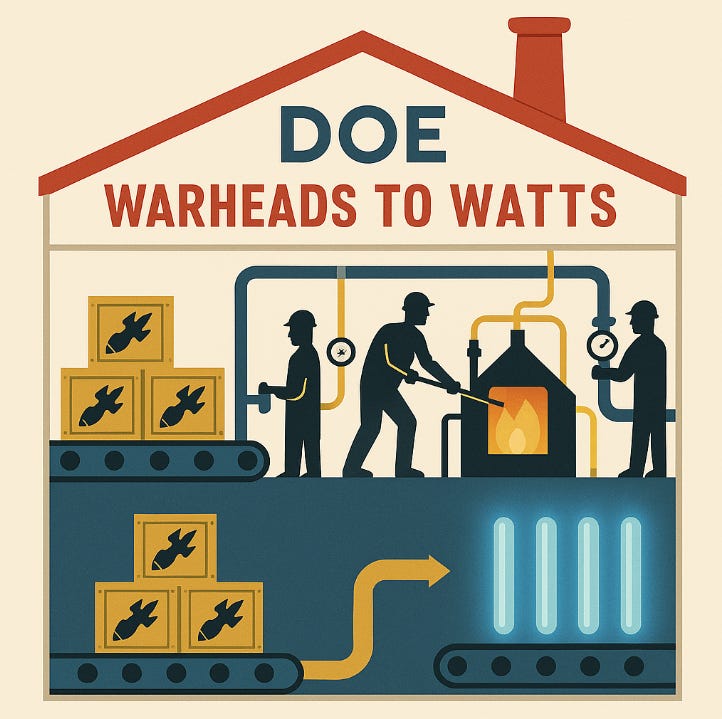From Warheads to Watts The Hoot this Week: 20th October - 24th October 2025
Ocean Wall Oct 24, 2025
This week, the U.S. Department of Energy took a striking step in its push for nuclear fuel independence, offering nuclear companies access to weapons-grade plutonium from dismantled Cold War warheads.

On Tuesday, the DOE published an application process allowing energy firms to apply for up to 19 metric tonnes of surplus plutonium held in federal stockpiles. The material, long stored under tight security, could now be converted into reactor fuel for a new generation of advanced reactors. The department says selected applicants could gain a faster path to regulatory approval, with the first awards expected by December 31st.
The move comes as Washington continues to break Russia’s grip on nuclear fuel supply chains. The U.S. produces less than 700,000 lbs of U3O8 per year, which equates to 1% of domestic need, while Russia still dominates the global market for HALEU.
Two developers, Oklo (backed by OpenAI’s Sam Altman) and France’s Newcleo, are among those expected to apply. Both firms are working on fast reactors designed to use recycled fuel, and Newcleo has pledged up to $2 billion in U.S. investment for advanced fuel-fabrication infrastructure.
Plutonium 101
Plutonium does not occur naturally in useful quantities; it is bred inside reactors from uranium-238. There are two practical types:
- Reactor-grade plutonium, produced as a by-product in conventional reactors after three years of fuel burn.
- Weapons-grade plutonium, produced deliberately for military use after only two or three months of irradiation, yielding a purer form of Pu-239.
Both are potent energy sources, one kilogram of Pu-239 can generate nearly eight million KW/hours of electricity, and both pose proliferation risks.
In practice, weapons-grade plutonium can be down-blended and fabricated into mixed oxide (MOX) fuel or used directly in fast reactors, which can fission nearly all plutonium isotopes. Four of the six Generation IV designs currently under development rely on this capability, making surplus plutonium an attractive strategic resource.

Before weapons material can be used as fuel, it is chemically converted into a stable oxide form, typically plutonium dioxide (PuO2). From there it can be blended with depleted uranium oxide to create MOX fuel, which substitutes for a portion of enriched uranium in conventional reactors. Because weapons-grade plutonium contains a higher concentration of the fissile isotope Pu-239, it performs efficiently in these blends and can serve as a clean, high-energy substitute for U-235 in thermal cores.
Fast neutron reactors, however, represent the most natural home for the material. Their harder neutron spectrum allows them to fission all plutonium isotopes, burning the element more completely and even converting excess plutonium into usable energy. In this way, plutonium from dismantled warheads can be transformed into long-term fuel, a literal warheads-to-watts cycle.
A Potential Shift in Fuel Markets
If implemented, the plan could temporarily ease U.S. uranium demand, particularly for demonstration reactors capable of running on plutonium-based fuels. The 19 tonnes being made available would cover only a small fraction of future requirements, yet the potential scale is far larger. As Stefano Buono, Newcleo’s founder and chief executive, noted, “With the 92,000 tons of spent fuel that the U.S. has, they could have 100 years of energy independence.” In other words, the country already sits on a vast untapped reservoir of recoverable energy that could underpin a closed-cycle fuel strategy for decades.
Still, the message is clear: Washington now sees “fuel independence” as encompassing the reuse of fissile material from its own arsenal. It could also accelerate licensing and testing programmes that have been slowed by HALEU bottlenecks and rising enrichment costs.
However, converting weapons plutonium into civil fuel is technically and politically complex. The previous U.S. MOX programme at Savannah River was cancelled in 2018 after severe cost overruns, and any new initiative will need to navigate similar challenges around reprocessing, licensing and funding.
Moreover, critics caution that placing weapons-grade material in commercial settings raises proliferation and theft risks, particularly if it is not secured to military standards. “Unless you get assurances that they’re going to protect it as though it is a nuclear weapon, then it’s going to increase vulnerability to theft,” said Edwin Lyman of the Union of Concerned Scientists.
The DOE’s plutonium initiative marks a pragmatic shift in U.S. nuclear policy: treating surplus fissile material as a strategic asset rather than a liability. It underlines Washington’s intent to rebuild domestic fuel capacity and reduce reliance on foreign suppliers, even if that means repurposing material once reserved for deterrence.
The plan could accelerate advanced-fuel development and demonstrate circular-fuel-cycle principles, but it also introduces new complexities in security, regulation and public trust. The success of this “warheads-to-watts” strategy will depend on whether companies can prove that weapons-grade plutonium can be safely, economically and transparently turned into power.
Quantum Leap Energy’s Creber Units: Turning Nuclear Waste into Reusable Fuel
Quantum?Leap?Energy?LLC (QLE), a subsidiary of ASP?Isotopes?Inc. (ASPI), has completed the acquisition of all assets of Canadian company One?30?Seven?Inc., including an international patent for treating radioactively contaminated water.
With this acquisition, QLE aims to develop its “Creber Units” modular systems designed to accelerate the beta-decay of water-soluble nuclear waste isotopes like Cesium-137 and Strontium-90, thereby advancing its vertical integration in the nuclear fuel-cycle business and addressing the global challenge of nuclear-waste storage.
A Game-Changer for Nuclear Waste
The Creber Unit is a breakthrough technology that could dramatically shorten the time it takes for nuclear waste to become safe. Normally, radioactive waste remains dangerous for thousands of years, but the Creber Unit uses targeted lasers to speed up the natural decay process, turning harmful materials like Cesium-137 and Strontium-90 into stable, harmless elements within days. These modular units can be small enough to fit in a shipping container or scaled up to serve full nuclear plants, making them flexible and cost-effective to deploy anywhere waste is produced.
“This initiative promises to reduce the environmental burden of the vast quantities of radioactive waste worldwide, particularly high-level waste, by advancing solutions that could stabilize hazardous isotopes, thereby safeguarding ecosystems and public health for generations to come.” – Ryno Pretorius, CEO of Quantum Leap Energy
Creating a Full Nuclear Fuel Loop
Today, uranium is mined, enriched into fuel, used in a reactor, and then stored as waste for thousands of years. But with Creber Units, the waste could be treated quickly and safely, allowing parts of it, like uranium and plutonium, to be re-enriched and reused in reactors. In other words, nuclear fuel could go from enrichment ? into a reactor ? through a Creber Unit ? back into enrichment ? into the reactor again. This “closed loop” system would make nuclear power far more sustainable, cheaper, and environmentally friendly by turning waste into reusable fuel instead of burying it underground.
Why It Matters
QLE’s first targeted nuclear waste isotope will be Cesium-137, which decays into stable Barium-137, a valuable material used in quantum computing, a field expected to grow from $3.5 billion to over $20 billion by 2030. This creates a powerful “waste-to-value” model, creating revenue from nuclear waste while producing materials for next-generation computing. If proven at scale, the Creber Unit could mark the first true circular economy in nuclear energy, reducing both costs and environmental impact while unlocking an entirely new market for recycled isotopes.
What Else Happened This Week?
Urenco Doubles Almelo Expansion, Strengthening Western Enrichment Capacity
Urenco has announced it will double its planned uranium enrichment expansion at its Almelo facility in the Netherlands. The initial phase, unveiled in December 2023, adds roughly 750,000 SWU (separative work units) and is on track to start operations in 2027. A newly approved second phase will build another centrifuge hall, adding a further ~750,000 SWU by 2030, bringing Almelo’s total new capacity to about 1.5 million SWU.
Globally, Urenco has now committed to 2.5 million SWU of new capacity, including its Eunice, New Mexico site where the first two centrifuge cascades are already running. The move highlights the growing urgency for Western enrichment capacity, especially for both low-enriched uranium (LEU) and high-assay low-enriched uranium (HALEU) needed for small modular reactors, as Russia and China still control roughly 60% of global SWU capacity.
Silex Achieves Major Milestone in Laser Uranium Enrichment
Silex Systems’ shares surged 22% to A$9.44, an 18-year high, after a third-party review validated its laser uranium enrichment technology. The independent assessment confirmed that Global Laser Enrichment (GLE), Silex’s U.S. licensee, achieved commercial-scale readiness. Silex CEO Michael Goldsworthy remarked he was “immensely proud of GLE, the only company in the world to have demonstrated large-scale, third generation laser-based enrichment technology at TRL-6 status.”
The move enables Silex to advance to detailed design stage and deployment at the Paducah Laser Enrichment Facility (PLEF) in Paducah, Kentucky.
Canada’ $3 Billion Grid-Scale SMR Project
Canada’s Prime Minister Mark Carney announced a CAD 2 Bn federal investment (plus CAD 1 Bn from Ontario) to build four small modular reactors at the Darlington New Nuclear Project, the first grid-scale SMR facility in a G7 nation. The project will power up to 1.2 Mn homes, create thousands of jobs, and cut 2.3 Mn tonnes of emissions annually, advancing Canada’s long-term energy security
Japan’s New Prime Minister Takaichi Puts Nuclear Power at the Core of Energy Strategy
Sanae?Takaichi, newly elected Prime Minister of Japan, has pledged to place nuclear power at the core of Japan’s energy strategy, emphasising national security and reducing dependence on imported fossil fuels.
She is also backing advanced nuclear technologies and signalling a shift away from large-scale solar renewables reliant on Chinese imports
Uranium Prices
 |







